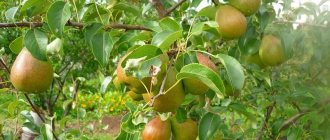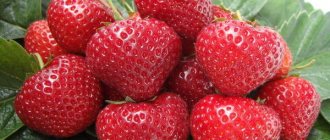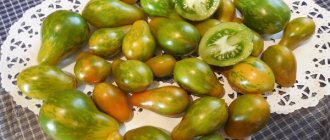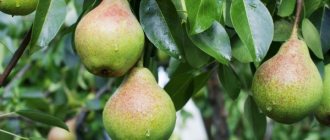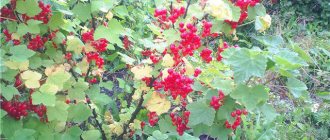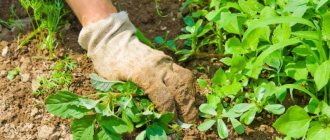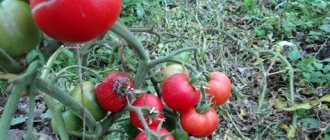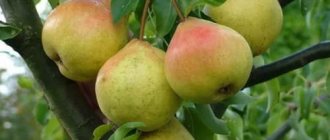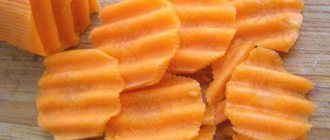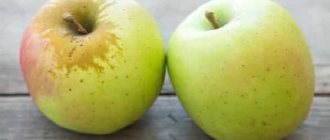Victoria pear: variety description and characteristics
Victoria pear: photo of variety
Victoria pear ripens in late summer, early autumn. The tree begins to bear fruit six years after planting. The tree blooms in June, when there can be no frost. The weather cannot in any way affect the development of culture. The Victoria pear variety is grown in large quantities and yields are high. From one variety the pear got its tolerance to the cold season, and from the other - the quality of the fruit.
- The size of the tree can grow up to five meters, the crown is scattered, not dense, rounded in shape, in the form of a trapezoid. The bark of the tree acquires a brown color, young wine-colored branches, as soon as a year of their formation has passed, become brown, like the whole tree.
- The leaves are emerald green, smooth, rounded, elongated. On young branches the leaves are brown with a reddish tint; after a while they become the same color as all the other leaves.
- Inflorescence and vegetation - this occurs at the end of spring. The inflorescence is regular, small snow-white buds appear, the growth is ring-shaped. Inflorescences are formed until the fruits begin to grow. They don't fall off. The development of the ovaries is one hundred percent.
Important! Victoria pear is suitable for growing in the southern territory. In Europe and the center of Russia it is impossible to grow this variety.
- DESCRIPTION OF THE FRUITS
Because of its quality, the Victoria pear variety is included in the composition of dessert varieties. There are very few such varieties; when ripe, they do not produce seeds. The harvest can be harvested in September, the fruits can lie for a sufficient amount of time. The culture itself is not dense, it is practically not prepared, but is eaten fresh.
Characteristics by appearance:
- The pear shape is good, without any complaints, symmetry.
- The fruit stalk is either straight or curved.
- Usually large fruits grow up to two hundred and sixty grams, but also small ones from one hundred and fifty-five grams.
- The skin is glossy, initially has a greenish color with brown spots, then the color changes to yellow, the spots become darker.
- Blush occurs only on one half of the pear.
- The skin is smooth, without cracks.
- The contents inside are juicy, smell delicious, no granules, soft.
- It tastes sweet, with a hint of sourness.
- The fruits are firmly attached to the stem and will not fall from the tree.
Attention! In order for Victoria pears to last a long time, they are placed in a refrigerator or cellar, where the temperature is about plus five degrees.
Victoria pear: detailed description of the variety, reviews, photos
The Victoria pear variety is very popular among Russian and Ukrainian gardeners, since it is practically free of disadvantages. Low maintenance requirements allow you to get huge volumes of harvest without any problems.
History of the variety's creation
The culture was bred by crossing at the Institute of Irrigated Horticulture in Ukraine. To do this, they used Tolstobezhka and Bere Bosk, which combine a huge number of positive features. They began testing the plant in 1974, and it was registered in Russia in 1993. "Victoria" feels excellent in the climate of southern latitudes, steppes and forest-steppes.
Main characteristics
The tree is of medium height, although sometimes tall. The crown is not too dense and has the shape of a rounded pyramid. The buds are mainly tied on the ringlets. After winter, awakening and flowering occurs late, therefore, the flowers do not suffer from cold weather.
Experts characterize the variety as frost-resistant, not afraid of drought and scab. They classify it as summer.
The culture is self-sterile and has a tendency to form fruits without seeds.
Gardeners note that fruits can change their taste depending on the weather.
Description of fruits
The fruits have a wide pear-shaped shape. The skin is smooth, moderately thick, and may be rusty. Once the pears are fully ripe, they acquire a yellow-green color with a bright pink blush. Under the skin you can see a large number of dots. The average weight of the fetus ranges from 150 to 250 grams, although record figures exceed 300 grams.
The composition includes approximately 13% dry matter, 7.8% sugars, 0.4% titratable acids, as well as ascorbic acid. The pulp is white in color, tender in taste, with sweet and sour notes. It is incredibly juicy.
Tasting assessment of the harvest - 4.5 points.
The purpose of the fruit is for table use; they are used mainly fresh and are not sent for processing. Without refrigeration, it can be stored for almost a month, and in the refrigerator this period is extended to 4 months.
Pollinator trees
If you want to increase productivity, you should place other varieties of this plant next to Victoria. Good options include the following varieties:
- Williams red;
- Nikolai Kruger;
- Triumph of Vienna.
Williams red Nicholas Kruger Triumph of Vienna
Prevention Tips
It is best to carry out prevention so as not to encounter diseases and pests. Very simple measures are recommended for this:
- Constant cleaning and burning of fallen leaves at the end of autumn.
- Digging up the soil around the tree in winter and in the first weeks of spring.
- Constant inspection of the ward, getting rid of bad branches.
Advantages and disadvantages
"Victoria" is distinguished by a huge number of advantages highlighted by gardeners. Of course, there are some minor drawbacks. It is very important to consider both to understand whether you want to grow it on your site.
pros
- Stable yield, characterized by abundance and high quality.
- Excellent taste characteristics and good presentation.
- The collected fruits can be consumed for at least a month.
- Representatives of this species are not afraid of frost and drought.
- Good immunity to scab.
- Not afraid of most parasites.
Minuses
There are no pronounced shortcomings; only a slight precociousness can be identified. Some gardeners say that due to cold weather and rain, the taste characteristics of the fruit deteriorate. Also, young seedlings must be covered for the winter.
Landing
In order for a crop to delight you with tasty pears, you need to plant it correctly. There is nothing particularly complicated in this process, but all the listed rules should be taken into account.
Soil preparation
The hole for planting must be formed in the fall by filling it with a layer of nutrient substrate.
If you plant a seedling in a freshly prepared hole, then over time the fertile layer will settle.
It is recommended to pierce the walls of the hole in several places with a pitchfork so that the root system receives the necessary oxygen.
Direct landing
At the bottom of the hole, a small hill is made, on which the young individual is placed, with the roots distributed on the sides. Periodically, the tree needs to be shaken to avoid air gaps.
As soon as the activities are completed, the seedling is well watered. If the soil subsides noticeably, it is advisable to add a few more layers and tamp them down properly. As a top dressing, you need to fill up a bucket of rotted manure, peat or compost. Fresh manure should not be used under any circumstances.
Care
In general, the plant is unpretentious, so care only includes systematic feeding, watering and pruning. In addition, it is necessary to add prevention against diseases and pests.
Watering
As for watering, “Victoria” can generally live safely on rainwater. If the summer is too dry, you can periodically add water, but it is best to keep the lump moistened as evenly as possible. If the humidity is different, the crop will crack.
Young pears require more frequent watering, about 10 times per season.
Feeding
An adult requires organic matter every few years at the rate of 4 kilograms of product per square meter. The fertilizer is distributed near the tree and the soil is dug up.
Minerals are used every year. Ammonium nitrate, potassium chloride and superphosphate are added to the water for irrigation.
The most effective way to fertilize is to spray the crop during bud setting, after flowering, during fruit formation and before winter.
Reviews
Sergey, Moscow : We have been growing this pear for a very long time. She pleases us with a large and stable harvest, which is very tasty. Unfortunately, it is not very suitable for processing, so we have to distribute it to our neighbors - we don’t have time to eat it ourselves. The plant is unpretentious in care, and for us this is ideal, since it is not possible to often go to the country.
Valery, Tula : Victoria is my favorite pear variety. The shelf life of the crop is quite acceptable; it lasts in the refrigerator for several months. The taste is pleasant - sweet, with light sour notes. When it comes to maintenance, the thing that causes me the most problems is pruning, but that's not that important.
Natalya, Sevastopol : If you are looking for which pear to plant on your plot, then choose Victoria. It is not afraid of adverse weather conditions, is not afraid of diseases and pests, that is, it is an ideal option for those who do not have the opportunity to devote every free minute to the garden. I am very pleased with this plant.
Victoria pear: advantages and disadvantages
Victoria pear: photo of variety
Victoria pear is grown for production purposes, sales, and also for personal use. Pros of culture:
- Regular and large harvest.
- High quality.
- Presented appearance.
- Tolerance to the cold season.
- Drought resistance.
- Transmissibility of scab disease and rodents.
- It can remain for a sufficient amount of time after collection.
Disadvantages include a decrease in glucose if there is insufficient light for the crops. And the fruit will taste sour.
The history of the creation of the Victoria pear variety
The Victoria pear was created by crossing at the Institute of Irrigated Horticulture of the Ukrainian Academy of Agrarian Sciences at the Melitopol Experimental Station by scientists E. A. Avramenko, I. N. Boyko, P. V. Grozditsky, G. I. Kulikov and I. N. Maksimova. The following varieties became the “parents” of Victoria:
- exceptionally hardy to all unfavorable factors, the unpretentious winter Michurin Tolstobezhka, which has the Ussuri pear in its pedigree;
- an ancient (late 18th century) French variety Bere Bosc, distinguished by excellent quality fruits and being the most common autumn variety.
The pear began to be tested in 1974. Registration in the Register of Selection Achievements of the Russian Federation took place in 1993 in the North Caucasus region. Plants are well adapted to the climatic conditions of southern latitudes, as well as steppes and forest-steppes of Ukraine. There is information about the successful growth of the variety in Belarus.
There is an opinion that Victoria has every chance of replacing Forest Beauty, which has the same ripening period - one of the most common varieties of pears.
Victoria pear: planting varieties
As we already know, the Victoria pear variety was bred in the north of the Caucasus, in Ukraine, and is also planted in Belarus. This variety is planted in the south. It tolerates frost, but weakly, so it is not recommended to plant this variety in northern and European territories.
Productivity is increased if everything is suitable for the crop according to the conditions, and the land is properly maintained. Trees also need light. If you grow the fruit in the shade, you can get small fruits with an acidic taste. The young branches are fragile, long, the inflorescence is regular, but a certain number of buds may fall off.
It is best to plant a pear in the south or east of the site; you also need to make sure that there are no strong gusts of wind.
The soil should be sandy or clay, you can combine it. If there are no options, then you need to plant acidic soil; in September, add lime or flour to the soil. This fruit can tolerate drought, but there is no stagnation in the soil. The crop is prohibited from being planted in lowlands, since there is a constant accumulation of moisture in these places; it cannot yet be planted in coastal areas.
- HOW TO PROPERLY PLANT AND CARE FOR A CULTURE?
The time for planting the Victoria pear variety is spring or autumn. The fruit should be grown specifically in the southern territories, so seedlings are not so often planted in the spring. Seedlings are often planted in the fall, twenty-one days before frost, which is approximately mid-autumn.
Seedlings should be selected with strong and healthy roots. Before planting, all shoots with errors are cut off. The bushes should be smooth, dark, without cracks or any other imperfections, and should be dense at a distance above the roots.
- HOW TO PLANT CORRECTLY?
The dimensions of the holes should be ninety by eighty centimeters. You need to dig seven days before planting. The soil must be saturated with nutrients and consist of sand and humus. Potassium and phosphorus are also added. The roots are left to soak for three hours in the Epin mixture, which helps the development of the roots.
Planting the Victoria pear variety one by one:
- In order for the seedling to stand straight, a support is added and driven directly into the hole.
- The first layer should be a fertile mixture with organic matter.
- Place the seedling so that the roots are located at a comfortable depth. If the seedling was grown in a pot before planting, then it is transplanted with a lump of earth from the pot and placed strictly in the middle of the hole.
- Fill the hole with fertile soil.
- They tie it to a peg and compact the soil.
- Moisturize.
Attention! The neck of the roots should be at soil level.
Planting and caring for pears
Planting a Victoria pear does not require special knowledge or experience, but must be carried out according to certain rules. At the same time, it is very important to choose high-quality seedlings and a suitable place for planting them, so that the young trees take root in the soil as quickly as possible and begin active growth.
This variety is easy to care for, but for good productivity, the trees will need a sufficient amount of water and nutrients, as well as regular pruning of the crown. It is equally important to properly prepare the Victoria pear for wintering. More on all this later in the article.
Landing rules
To regularly receive a generous harvest of ripe fruits, you need to find a good place to plant seedlings. In an unsuitable area, trees will not grow well and the likelihood of diseases will increase.
Find out how to make a pear blossom and bear fruit.
To plant Victoria pears, you need to choose a place that meets the following requirements:
- good sunlight - necessary for active growth of shoots and the sweet taste of fruits;
- location on the south or southeast side will provide the tree with the necessary amount of heat, which will have a beneficial effect on the yield;
- absence of cold drafts - will help prevent the occurrence of pear diseases and falling off of inflorescences;
- sandy loam or loamy soil of loose consistency and neutral acidity - it allows air and water to pass well to the roots;
- good air circulation - it helps prevent the occurrence of fungal diseases;
- location away from groundwater - if it is close to the soil surface, it can cause rotting of the tree roots;
- a flat surface of the ground on the site - rain and melt water can accumulate in a lowland or depression, which will have a bad effect on the root system of the pear.
Planting hole size: 90x60 cm After choosing a site, they proceed to purchasing planting material.
It is recommended to purchase it from trusted buyers or in special stores. High-quality pear seedlings must meet the following basic requirements:
- age 1-2 years - such trees are strong enough to quickly take root in open ground;
- a developed root system consisting of elastic fibrous roots - there should be no damage, dry areas or growths on them;
- elastic and smooth bark without mechanical damage, traces of diseases and signs of pest damage.
It is recommended to plant seedlings of the Victoria variety in the fall 3-4 weeks before the onset of frost - approximately in mid-October.
But when growing in a region with a cool climate, it is better to plant trees in open ground in early spring so that they are not damaged by severe frosts. Important! When planting in spring, holes for seedlings are dug in the fall. If young trees are planted on the site in October, then the holes for them are prepared 1-2 weeks in advance.
Step-by-step instructions for planting Victoria pears are presented below.
- Dig planting holes in advance with a diameter of 90 cm and a depth of 60–70 cm. Trees should be placed on the site according to a 4x5 m pattern.
- For each hole, prepare a nutritious soil mixture of soil, compost, sand and peat, taken in equal quantities, and then add 300–400 g of superphosphate and 3–5 liters of ash.
- Form a small mound at the bottom of the hole using half of the prepared soil mixture and drive a wooden support in the center. Then leave a hole for the soil to settle.
- Before planting, immerse the roots of the seedling in a growth stimulator solution for 2-3 hours. Then remove damaged and dry areas of roots.
- Lower the roots of the young tree into the hole, spreading them on the surface of the mound of nutrient soil. The root collar should be slightly above the surface of the ground.
- Sprinkle the pear seedling with the remaining mixture and soil so that there are no voids between the roots and the soil. Compact the soil around the tree trunk, forming a tree trunk circle.
- Water the planted tree generously and tie it to a support. Cover the surface of the earth around the trunk with a layer of compost or rotted sawdust 10–15 cm thick.
Pear planting scheme.
Watering and fertilizing
Mature trees of this variety grow well and bear fruit even in arid climates and infrequent watering, and when grown in regions with moderate rainfall, rainwater is sufficient for them. But young seedlings need to be irrigated more often - this will help speed up their growth.
Did you know? In the 18th century, the pear was called the “butter fruit” for the soft and oily consistency of its pulp.
Rules for watering Victoria pears are listed below:
- young seedlings up to 5 years old can be irrigated no more than once a week, spending 10 liters of water on each tree;
- You cannot water the pear too much or too often - this causes rotting of the root system;
- In dry summers, mature trees are irrigated before and after flowering, and then 2-3 more times during the formation and ripening of fruits;
- in case of rain, watering is carried out no more than 2-3 times a season;
- to irrigate the soil under mature trees, use 30 liters of water per 1 m² of area around the trunk;
- you can water using a sprayer - this will prevent erosion of the soil around the roots of the tree;
- The last time the pear is watered is in late autumn, so that the roots are saturated with moisture and the tree can better withstand the winter;
- The earthen clod should not be allowed to dry out too much - sudden changes in soil humidity can cause the fruits to crack.
The Victoria pear responds well to fertilizing, so it is recommended to apply it regularly, starting next year after planting the seedling. Nitrogen-containing fertilizers stimulate tree growth in the first years of life, and mineral supplements with potassium and phosphorus help increase crop yields and improve the taste of fruits.
The basic rules for applying fertilizers are listed below:
- organic matter is added every 3-4 years while digging up the earth around the trunk in the fall or spring, spending about 4 kg of humus, peat or compost per 1 m²;
- in early spring, the pear is fed with nitrogen-containing fertilizers (nitrate, urea or nitroammophos) - the substances are added while digging the tree trunk at the rate of 30–40 g per 1 m²;
- before flowering begins, foliar feeding of the pear with boric acid is carried out - 2 g of the substance is dissolved in a bucket of water and the crown is irrigated with the resulting solution;
- after flowering (at the beginning of summer), fertilizers with potassium are applied to the trees, dissolving them in water for irrigation - about 10–20 g of the substance are consumed per 1 m²;
- during the growth and ripening of the fruit, the pear can be watered 2-3 times with an aqueous solution of mullein - 2 liters of the substance are diluted in 10 liters of water and infused for a week, and then diluted with water (in a ratio of 1:10) and applied to 1 m² of the trunk circle 10 l of the resulting liquid fertilizer. The interval between treatments is 2-3 weeks;
- in late autumn, the tree is fed with preparations containing phosphorus - while digging the soil around the trunk, 30–40 g of superphosphate is added per 1 m².
Victoria pear: variety care
Victoria pear: photo of variety
- HYDRATION AND NUTRITION
The Victoria pear produces its first fruits only six years after planting. After planting, there is no need to feed the seedling. The soil should be moistened once a month during drought. Does not require watering when there is heavy rainfall.
The Victoria pear variety needs to be nourished when it blooms, using saltpeter or urea. As soon as the fruits begin to develop, they are fed with Kafor K, and when the fruits ripen, they are fed with magnesium sulfate. Before the winter period, they weed the ground around the tree, remove weeds, nourish it, and insulate it. To remove acid, you should water the soil with lime, once every four years.
- CUT
The cut should be made in the spring, after planting in the fall. Usually one third of the branch is cut off. Next, the branches of the crown are cut off to rejuvenate it:
- The branches from below are cut so that they are horizontal, and they are tied in this position. Enter the first skeletal circle.
- Then in the spring they reduce it by one fourth, and the upper branches are broken off in the fall.
- Next, a skeletal circle is made from a pair of branches, they are cut shorter than the previous one.
- The third skeletal circle of three branches, they are cut off like the rest.
After five years, the crown of the tree will be rounded in the form of a trapezoid. There is no need to cut off a large number of branches anymore. In the spring, dry branches are cut off and preventive work is carried out against diseases and insects.
- HOW TO WHITECH WOOD CORRECTLY AND WHY?
The time of the procedure is the spring and autumn periods, whitening is done at a distance of one hundred centimeters from the soil. Lime, acrylic or water-based emulsion is used. This procedure is considered prophylaxis for the culture. Because insect larvae, rodents, and fungus appear in the tree during the winter. Another advantage of the bleaching process is protection from direct sunlight.
- TRANSITION TO WINTER
The Victoria pear variety is usually grown in areas with a good warm climate; the variety can easily withstand winter, since this is inherent in it from planting. Thus, the young tree is not mulched. If there is little rainfall during the growing period, then the tree should be moistened; mulch, sawdust, peat and foliage should also be added to the soil.
- PEAR POLLINATORS VICTORIA
Male and female inflorescences grow on this tree. The Victoria pear variety can be grown without neighboring crops. But you can also increase the yield several times. If you plant similar varieties nearby that bloom at almost the same time. For example, “Triumph of Vienna” or “Williams Red”.
- HARVESTING
The inflorescences do not fall off after opening and also remain on the tree. Also, the ovaries do not disappear; they ripen to the end. When growing a variety in an open place where the sun constantly shines, the yield can be up to one hundred and sixty kilograms, it can also be higher, about one hundred and eighty kilograms, this can be during a warm, rainless summer season.
Diseases and pests
Victoria pear: photo of variety
The most dangerous enemy for a tree is scab, but this species carries this disease. But there are also those that affect this culture:
- Moniliosis - symptoms: gray spots on the fruit, then the fruit rots. Infected fruits hang on the tree, therefore healthy fruits intercept the infection. To combat such a disease, the first step is to remove contagious pears.
- Powdery mildew - a grayish coating appears on the entire tree. For protection, diseased branches are cut off and the tree is cleaned with special preparations, for example, “Sulfite” or “Fundazol”.
- Black cancer - can be found not so often, the symptom is corrosion. If treatment is not started, the disease will spread from the trunk to the branches of the crown. Therefore, you should spray the wood with special solutions that contain copper. In autumn, leaves and branches are burned.
- Pests – not many of them spread on this crop. If a brown fruit mite appears, then the drug “Oleocuprit” will help you; this should be done in the spring. In the summer season, the variety is disinfected with colloidal sulfur, as well as Acartan. Galitsa also appears on the leaves; it is removed with the help of “Zolonom”, “Nexionom”, and also “Karbofosom”.
Victoria pear: reviews from gardeners
Petrov Sergey Igorevich, forty-one years old, Kostroma
“We have several trees planted on our site; now we are pleased with the Victoria pear with its harvest. The variety took about seven years to develop, and I was sure that it would not produce any fruit. As a result, I collected about a hundred kilograms. The taste is very sweet, there is a hint of sourness, but this adds juiciness to it. This is the only seedless crop I grow. My tree has never had a disease before, because every spring my wife and I disinfect the tree with copper sulfate.”
Sergeeva Vitalina Dmitrievna, fifty-six years old, Sevastopol
“Victoria pear is my favorite crop in the country. The fruits ripen are very tasty and sweet. I collect them at the end of summer, then keep them in the cellar until winter. I don’t make canned fruit from the fruit because it produces a strong liquid. We eat it fresh, or make juice and leave it until the new year. The Victoria pear variety was planted to suit our weather conditions; it tolerates the winter period, as well as heat and drought. We reap a big harvest, the inflorescences don’t fly away.”
Main characteristics
Victoria pear belongs to the summer category, and full ripening of the fruit occurs already in the third ten days of August. At this point, pears have already stopped growing and begin to accumulate useful microelements and vitamins. The fruit pulp is somewhat hard, so for full fresh consumption, it is better to collect the fruits in the first half of September. These fruits are distinguished by their delicate aroma, good taste and juiciness of soft pulp.
The harvested crop can be stored for about a month; if artificial cooling conditions are used, the period increases slightly. Thanks to this, pears can easily withstand long-term transportation and are suitable for cultivation for further sale. The fruits are mainly consumed fresh. It is recommended to grow the variety in southern regions with warm climates. At the same time, the trees themselves can easily withstand winter cold and prolonged lack of moisture.
The trees are distinguished by their medium height and crown with a rounded pyramidal shape. The density of branches and foliage is average. Most fruits ripen on the ringlets. The beginning of the growing season and the flowering of trees occurs somewhat later than usual, but this is precisely what protects the crop from possible loss due to unexpected returning spring frosts.
The ripening fruits are medium in size and have a regular pear-shaped shape with a characteristic one-dimensionality. The peel of pears is smooth, gradually changing from a green-yellow color to a bright, beautiful blush. The inner pulp is white, delicately juicy and has a distinct aroma. The concentration of healthy sugar in ripe fruits is about 7.8%.
